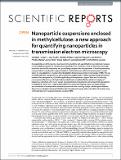Nanoparticle suspensions enclosed in methylcellulose : a new approach for quantifying nanoparticles in transmission electron microscopy
Abstract
Nanoparticles are of increasing importance in biomedicine but quantification is problematic because current methods depend on indirect measurements at low resolution. Here we describe a new high-resolution method for measuring and quantifying nanoparticles in suspension. It involves premixing nanoparticles in a hydrophilic support medium (methylcellulose) before introducing heavy metal stains for visualization in small air-dried droplets by transmission electron microscopy (TEM). The use of methylcellulose avoids artifacts of conventional negative stain-TEM by (1) restricting interactions between the nanoparticles, (2) inhibiting binding to the specimen support films and (3) reducing compression after drying. Methylcellulose embedment provides effective electron imaging of liposomes, nanodiscs and viruses as well as comprehensive visualization of nanoparticle populations in droplets of known size. These qualities facilitate unbiased sampling, rapid size measurement and estimation of nanoparticle numbers by means of ratio counting using a colloidal gold calibrant. Specimen preparation and quantification take minutes and require a few microliters of sample using only basic laboratory equipment and a standard TEM.
Citation
Hacker , C , Asadi , J , Pliotas , C , Ferguson , S G A , Sherry , L , Marius , P , Tello , J , Jackson , D , Naismith , J H & Lucocq , J M 2016 , ' Nanoparticle suspensions enclosed in methylcellulose : a new approach for quantifying nanoparticles in transmission electron microscopy ' , Scientific Reports , vol. 6 , 25275 . https://doi.org/10.1038/srep25275
Publication
Scientific Reports
Status
Peer reviewed
ISSN
2045-2322Type
Journal article
Description
This work was supported by the University of St Andrews and Nanomorphomics group funds. The work forms part of an International Patent Application No. PCT/GB2015/052482.Collections
Items in the St Andrews Research Repository are protected by copyright, with all rights reserved, unless otherwise indicated.

